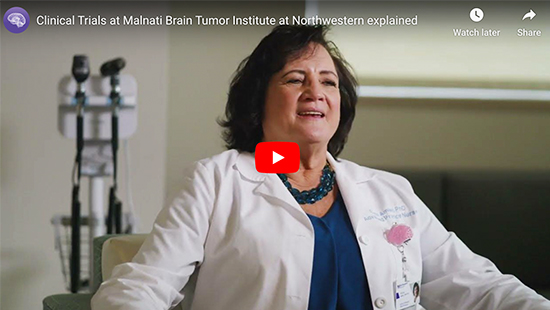Clinical Trials
The Northwestern Medicine Lou and Jean Malnati Brain Tumor Institute of the Lurie Cancer Center is committed to providing the most advanced treatments available for patients with brain and spine tumors, and to developing clinical research that will lead to tomorrow’s care.
For best results, use specific search terms (e.g., "glioblastoma" instead of "brain tumor") below. We do our best to keep these listings up-to-date, but we may sometimes have trials available that are not yet listed. To inquire about other clinical trials or to learn more about the clinical trials listed here, please contact cancertrials@northwestern.edu or call 312-695-1102. You can also view a list of open Lurie Cancer Center clinical trials for all types of cancer.
| Trials |
|---|
NUDB 13C03: Northwestern Brain Tumor Institute Research DatabaseThe Northwestern Brain Tumor Institute (NBTI) currently uses an electronic database to collect and store information about patients who come to the NBTI for evaluations, including diagnosis, treatment, follow-up, and/or to obtain additional opinions. This database is called the Northwestern Brain Tumor Institute Database or NBTIDB, and it … The Northwestern Brain Tumor Institute (NBTI) currently uses an electronic database to collect and store information about patients who come to the NBTI for evaluations, including diagnosis, treatment, follow-up, and/or to obtain additional opinions. This database is called the Northwestern Brain Tumor Institute Database or NBTIDB, and it was developed to replace older paper methods for collecting and storing information. The purpose of this study is to allow researchers involved with the NBTIDB to use data stored in it for future research studies and projects. The NBTIDB also allows researchers to track whether or not patients have agreed to allow their information to be linked to their leftover tissue samples, which are kept in the hospital’s pathology department, for future research studies. Eligibility Criteria You may be eligible to take part in the research component of the NBTIDB if you are either a new or returning patient, over the age of 18, who is being seen by one of the clinicians at the NBTI and are or will be entered into the NBTIDB, or a patient who is not coming to the NBTI for evaluation, but would still like to participate in the NBTIDB. Location(s)
IRB number STU00087359 Copy Study URL to Clipboard Copy |
A Phase 2, single arm, multi-center, open label trial Combining Optune with concurrent Bevacizumab in the setting of Recurrent or Progressive MeningiomaPurpose
The purpose of this research study is to determine the effects (good and bad) bevacizumab (the study drug) combined with Optune (the study device) tumor treatment field therapy has on meningiomas.
Overview
Bevacizumab (the study drug) is considered investigational because the US Food and Drug Administration (FDA) has not … Purpose
The purpose of this research study is to determine the effects (good and bad) bevacizumab (the study drug) combined with Optune (the study device) tumor treatment field therapy has on meningiomas.
Overview
Bevacizumab (the study drug) is considered investigational because the US Food and Drug Administration (FDA) has not approved its use for the treatment of meningiomas. The study drug is a medication that blocks the growth of new blood vessels. In order for tumors to grow they need to have a blood supply. Tumor cells have been shown to produce substances that stimulate the abnormal growth of new blood vessels that allow the tumor to grow. It is thought that the study drug may interfere with the growth of new blood vessels and therefore might stop tumor growth, and possibly shrink the tumor by keeping it from receiving nutrients and oxygen supplied by the blood vessels.
Optune (the study device) is also considered investigational because the US Food and Drug Administration (FDA) has not approved its use for the treatment of meningiomas. The study device, Optune is a device that the patient will wear and use for at least 18 hours of each day. It delivers alternating electrical current to the patient‰Ûªs brain tumor and by doing so interrupts a process called mitosis. Mitosis needs to occur in order for cell division to occur and allows tumors to grow. By slowing this process, we hypothesize that meningioma growth may also be slowed.
Description of Treatment
Tumor treatment field therapy with Optune will be initiated at the same time as bevacizumab, with both treatments to start within a one-week period of each other. Bevacizumab will be given at current standard central nervous system (CNS) dosing of 10mg/kg q2 weeks in an outpatient setting. After 4 cycles (1 cycle=28days) of therapy (Cycle 5 day 1) patients may choose to switch to bevacizumab at a dose of 15 mg/kg q3 weeks. For patients who chose to make this switch, they have to do it on Day1 of a new cycle. Tumor treatment fields with Optune will be delivered for at least 18 hours a day at a frequency of 200 KHz and intensity of 1-3V/cm. Treatment will be continued until disease progression or up to 1 year. Eligibility Criteria"Some of the eligibility criteria include: - Patients must be age = 18 years. Both males and females and patients from all ethnic backgrounds are eligible. - Patients must have a histologic diagnosis of meningioma, WHO grade 2 or 3 (atypical or anaplastic). - All patients must have developed recurrent disease/progression after receiving all standard treatments. Note: This is only a partial list of eligibility criteria. Please contact the Lurie Cancer Center for complete screening information if you are interested in this clinical trial." Location(s)
Copy Study URL to Clipboard Copy |
